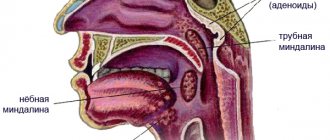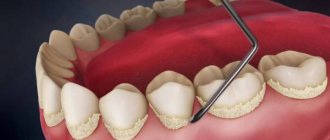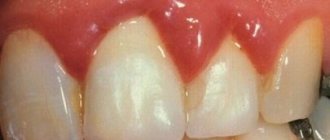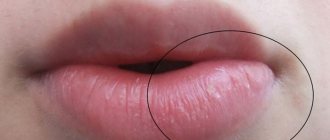Why does pathological formation occur?
The main reason for the development of the pathological process is injury to the soft tissue of the gums. The disease also often develops against the background of:
- Caries.
- Inflammation of the gum pocket.
- Violation of the rules of oral hygiene.
- Infectious diseases: tonsillitis, furunculosis, etc.
Pathology is characterized by gradual development:
- The initial stage is characterized by the appearance of mild pain when touching the gums.
- In the second stage, swelling and redness of the gums develop, and the pain becomes intense.
- If left untreated, pus appears in the gum pocket, body temperature rises, and swelling spreads to the cheek.
- Next, an extensive inflammatory process develops, characterized by the appearance of acute throbbing pain and an increase in the area of edema. The patient's general condition deteriorates significantly.
Causes of pathology
Before we tell you how to rinse flux, let’s explain why it occurs. Among the main reasons:
- progressive caries, when microorganisms from the resulting cavity penetrate the pulp and roots;
- poor-quality filling of teeth and canals;
- decreased immunity;
- inflammatory gum disease that has a chronic course;
- dominance of pathogenic microflora in the oral cavity.
It is necessary to establish the cause of the disease and only then treat it. Then the risk of flux recurrence will be much lower.
Types of disease
Flux is classified according to its development into the following types:
- Odontogenic. Pathology occurs against the background of advanced diseases of teeth and gums,
- Hematogenous. The disease develops when infection penetrates through the circulatory system.
- Lymphogenic. The cause of the disease is pathogenic microorganisms in the lymphatic system.
- Traumatic. Flux occurs at the site of injury to the periosteum, often after unsuccessful dental procedures during dental treatment.
According to the degree of spread, the following types of disease are distinguished:
- An ordinary flux that does not affect the periosteum.
- Fibrous flux, characterized by the onset of inflammation in the tissues of the periosteum.
- Orthodogenic flux, which develops as a complication - osteomyelitis, which requires tooth extraction.
- Albuminous flux, characterized by a chronic course, subfertile temperature and the occurrence of suppuration.
How does flux appear?
Flux occurs during an inflammatory process in the connective tissues that are located around the tooth. In this case, inflammation with pus appears, the tissues swell, and the area of the diseased tooth hurts. Most often, flux appears due to the penetration of infection from a diseased tooth into the pulp area. The disease is dangerous due to the fact that when the pulp is damaged, its tissue begins to die, and for this reason the patient no longer feels severe pain and decides that there is no need to see a doctor for now. At the same time, the absence of pain does not mean that recovery has occurred, and untimely treatment leads to serious complications. And it often happens that the patient is so afraid of the dentist that he decides to endure even severe pain until the last.
Diagnostic methods and treatment methods
An accurate diagnosis is a guarantee of successful treatment. To do this, the doctor conducts the necessary examination. It includes a diagnostic examination and fluoroscopy. To assess the degree of the inflammatory process, laboratory blood tests are performed.
There are two methods of flux treatment used in dentistry:
- Making an incision on the gum to open the purulent sac. After removing the pus, drainage is installed, which prevents premature healing.
- Cleaning an abscess through a root canal. This procedure is carried out when the cause of the flux is caries or the infection has penetrated through an existing crack in the tooth.
Special rinses are effective in treating flux. Solutions have regenerating and anti-inflammatory properties, therefore they can speed up healing. The simplest composition that can be used for rinsing with flux is a soda solution. If you carry out the procedure every couple of hours, you can quickly reduce pain and inflammation. To prepare the composition, dissolve a couple of teaspoons of soda in a glass of warm water. This amount of solution is enough for a day.
You can reduce swelling with a weak solution of manganese. This composition has strong disinfectant properties, which makes it possible to fight pathogenic microorganisms. For a similar effect, you can use the antiseptic agents Chlorhexedine or Miramistin. These drugs need to be used to irrigate the oral cavity.
An effective medicinal preparation for rinsing is Rotokan. It has a natural composition and contains extracts of chamomile, yarrow and calendula. For the solution, one spoon of the product is dissolved in a glass of warm water. Rinsing is carried out 4-5 times a day.
Folk recipes
Herbs and plant extracts have a beneficial effect on oral tissues. They can be used to relieve inflammation. When dealing with flux, you should arm yourself with:
- Oak bark. An infusion is prepared from it: pour two spoons into 200 ml of boiling water and wait for one hour. After filtering, the composition is ready for use. All products based on oak bark stain teeth. This is their significant drawback.
- Sage. You should mix a teaspoon of aromatic dry raw materials with a glass of hot boiling water. After half an hour, filter. During the procedure, the medicine should be slightly warm.
- Chamomile. Very popular for various dental diagnoses. Excellently suppresses inflammatory processes. Antiseptic. It can be combined with string and yarrow. The preparation recipe is standard: a tablespoon of vegetable mixture per glass of boiling water.
- Propolis. Suitable for making tinctures with alcohol. It must be infused strictly at room temperature. Dilute a teaspoon in a cup of water and rinse the flux in the morning, afternoon and evening.
Recommendations after opening the flux
When the first symptoms of flux development appear, you should not self-medicate. It is a mistake to believe that swelling and pain can be relieved with warm compresses, lotions based on herbal infusions or other folk remedies. Independent experiments aimed at combating flux can lead to complications.
It is important to remember that you should not take painkillers less than 3 hours before visiting the dentist. Otherwise, there will be problems with making a diagnosis. After the tooth flux has been exposed, you should not take aspirin, as it increases the risk of bleeding. If after 12 hours the condition has not improved, you should consult a doctor immediately.
Diagnosis of tooth flux
At the dentist's appointment, a thorough examination of the oral cavity and an X-ray examination - a targeted or panoramic image - is carried out. In some cases, two studies will be required to make an objective diagnosis.
As soon as the diagnosis is made - exacerbation of chronic periodontitis and the diseased tooth is identified, the doctor begins treatment.
Prevention
Understanding what gumboil is, you need to monitor the condition of your teeth and gums. Prevention consists of following hygienic rules for caring for the oral cavity. It is important to buy a quality toothbrush and good toothpaste to minimize the risks of developing caries. You need to brush your teeth twice a day: morning and evening.
After eating, it is necessary to remove food debris from the interdental spaces and use a mouth rinse to treat the oral cavity. To do this, you can buy the product at the pharmacy or prepare it based on propolis tincture, sea or table salt.
It is important to visit the dentist twice a year for preventive examinations. All diseases at the initial stage are successfully treated. Tartar should be removed regularly. It is in these deposits that pathogenic bacteria multiply, which, if the soft gum tissue is accidentally injured, can cause the development of gumboil.
To strengthen your gums, you must include fresh fruits and vegetables in your daily diet: apples, carrots, etc. They clean plaque on tooth enamel, which reduces the likelihood of tartar formation.
Symptoms
The clinical picture depends on factors such as the localization of inflammation and the causes of its occurrence, the body’s resistance, and the duration of the disease. Patients experience:
- redness of the mucous membrane;
- enlargement of the submandibular lymph nodes;
- deterioration of health;
- loss of appetite;
- weakness;
- temperature rise is possible.
Patients complain that not only the tooth hurts with gumboil: the painful sensations radiate to the ear, temple, and neck. In addition, swelling appears, due to which facial features lose their configuration. Depending on the location of the pain, the cheeks, upper or lower lip, chin, zygomatic and infraorbital areas swell from the flux. At the same time, the mobility of the jaw and lips is limited, and the patient has difficulty opening his mouth. The pain can be periodic: relief occurs when purulent exudate periodically pours into the oral cavity through the formed fistula.
In chronic periostitis, the symptoms are less pronounced. The pain is periodic, not severe, the contours of the face change slightly.
What happens if you ignore warning signs?
If inflammation is not eliminated, over time the pathological process will destroy bone tissue, which will lead to loss of teeth. In addition, pus accumulated in soft tissues can enter the intermuscular space or subcutaneous area. This can lead to melting of nearby tissues, requiring the intervention of an oral and maxillofacial surgeon.
It is difficult to treat a prosthetic tooth; this will require unfilling the canals, conducting anti-inflammatory therapy, and filling the canals again. If the inflammation has affected the root apex, surgical intervention will be required - resection of the apex along with the granuloma or cyst.
The doctor decides how to relieve pain under the crown individually in each clinical situation, based on the cause, stage, and extent of inflammation. Sometimes the situation goes so far that the only effective treatment method is the removal of a tooth followed by prosthetics.
Rules for using flux soda
Soda helps relieve pain and reduce swelling, sometimes it is possible to completely get rid of the gumboil, but the reason for its appearance will remain and sooner or later everything will happen again. It will not be possible to solve the problem without a dentist, so do not delay your visit. In the meantime, please note a few rules:
- Do not prepare the baking soda solution ahead of time. A portion should be used during one procedure, then the alkali loses its beneficial properties.
- It is advisable to use solutions rather than applications so that the soda powder does not burn the mucous membrane.
- Do not increase the concentration of the solution - the therapeutic effect will not become greater.
- The temperature of the solution should be about 20-22 oC.
- Try not to drink or eat for at least 40-60 minutes so that the substance has time to take effect.
Take care of your teeth
Tooth gumboil: what medications to take?
This is the most common question in Internet search engines when people try to deal with the problem on their own. Our answer: “Do not take anything before consulting a doctor!” Only the attending physician, taking into account the stage of the disease and your individual characteristics, can prescribe an antibiotic for tooth flux, which stops the inflammation process. The dentist will also advise which drug is best to use as an anesthetic.
Ointments and gels
Local use of ointments for periostitis contributes to the rapid extinction of inflammatory processes, faster healing of damaged tissues, and effective elimination of pain.
Vishnevsky ointment
With flux, Vishnevsky ointment can stop the development of the purulent process, quickly eliminate tissue swelling and relieve toothache. The xeroform included in the drug has an antibacterial effect, birch tar increases blood flow at the site of injury, and castor oil promotes deeper penetration of medicinal components.
Vishnevsky ointment is used in the initial stages of the disease or after opening the abscess. The drug is applied to a sterile small gauze pad and applied to the skin of the cheek in the area of inflammation for several hours.
You cannot use Vishnevsky ointment if you suspect the presence of a purulent focus at the site of periostitis. This can cause worsening of the condition and the development of complications.
Metrogyl denta
The drug is available in the form of a gel, which contains antibacterial components: metronidazole and chlorhexidine. Therapeutic substances penetrate perfectly into the source of inflammation, quickly relieve pain, eliminate tissue swelling and prevent the development of purulent complications. The gel is generously applied directly to the gum mucosa above the site of periostitis. After using it, you should refrain from drinking or eating for at least 30 minutes. The procedure is repeated three times a day until the inflammatory reactions subside.
Levomekol
The ointment contains ingredients that have a wide spectrum of antibacterial activity and promote rapid tissue regeneration. Levomekol does not lose its properties in the presence of pus, therefore it is preferable in cases where it was not possible to avoid the process of suppuration. The ointment is used three times a day. It is applied to a sterile gauze or cotton swab and applied to the flux for 2-3 hours. If a purulent focus has been opened, the drug can be injected directly into the resulting cavity. It is necessary to treat dental flux with Levomekol until complete recovery.
Important rules for treatment
During treatment you should follow several tips:
- Flux cannot be cured by rinsing alone;
- It is not recommended to prepare the rinse in advance, and the prepared solution should be used at a time;
- you cannot increase the dosage of the drug, you must strictly follow the prescription so as not to cause harm;
- water for use should be warm, not hot;
- sodium bicarbonate should be added immediately to warm water, not to boiling water and cooled;
- You should not drink or eat food for at least half an hour after the procedure.
Sodium bicarbonate is a universal remedy that has no contraindications. But there are still cases when its use is prohibited:
- You cannot rinse the mouth of a small child with a soda solution, as he does not yet know how to spit out the liquid and may swallow the product.
- You should not use baking soda immediately after surgery or tooth extraction, as rinsing prevents the formation of a blood clot, which is necessary to protect the wound.
- It is not recommended to use this remedy for stomach ulcers.
Recommended for you:
Baking soda against: germs, bacteria, viruses
Following these recommendations, the treatment will proceed without complications.











